The children and I are always looking for easy ways to remember which tree is which. Much to the children’s dismay, it’s not always so simple. The first thing we learned was that the seeds of a tree are called its fruit. Some seeds seem like they have parachutes, think of the fluffy “wishies” that float in the air. Think of the sycamore tree as having a brown wishie. Some seeds have blades like sailboats and catch the wind, twirling effortlessly to the ground. Think of the maples and Tulip Poplar. And then there are the nut seeds like the oaks.
I’m using some photos from our walk around the neighborhood, looking at the trees to help clarify the information we are sharing. After our walk, we went home and researched further online or in our tree and nature books to learn more about the trees. This post is a summary of what we learned.
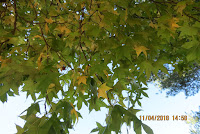 |
| American Sweet Gum Tree |
The American Sweet Gum tree is the star tree with the spiky balls as my children calls it. Many children identify trees by describing their leaves and seeds. This is a great way to have children pay attention to detail. Have the children look around the base of the tree or even up into the tree for clues as to its identity.
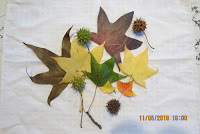 |
| Sweet Gum leaves and seed pods |
We found out that the Sweet Gum is among the last trees to leaf out in the spring and among last trees to drop leaves in fall. It has deeply-lobed, star-shaped leaves. The seeds for this tree burst out of the pods. You’ll notice in my photo the green pods are closed. Once the seeds explode out, the pod has open portals and turns brown. We found both kinds of pods on the ground.
 |
| Sycamore Tree |
The Sycamore tree is the easiest one for my children to identify by the trunk of the tree. The sycamore is the peely-barked tree. In other words, the tree sheds its bark. A sycamore can be called a buttonwood tree. It is a North American plane tree with broad leaves measuring almost six inches and has three to five lobes. The seeds are tightly packed in a soft hairy ball that blows apart in strong wind. Think of tawny wishies here. It’s not a woody ball like the sweet gum.
 |
| Sycamore seed |
American Sycamores have smooth, whitish bark, which peels off in large flakes. Splotches, where bark has peeled off, can be brown, green, or gray. These trees grow near rivers, streams, or lakes. They need moist, but well-drained ground.
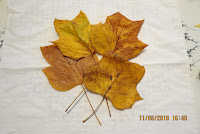 |
| Tulip Poplar Tree leaves |
The Tulip Poplar treeis the cat face leaf tree. If you look at the leaf of this tree, it looks like a cat face. The leaves have four points on them. They have winged seeds, like little helicopter blades, but we couldn’t find any on the ground. I use an internet picture here. This fruit [or seeds] is a cone two to three inches long, made of a great number of thin narrow scales attached to a common axis. Each cone contains sixty or seventy of these scales, of which only a few are productive.
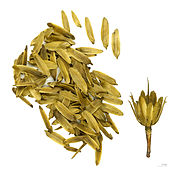 |
| Tulip Poplar seeds |
Tulip trees are large and grow to a great height. On an average, these trees grow up to 80-100 feet tall. The tallest tulip tree found on the Earth is about 200 feet tall. A distinguishing characteristic feature of this tree is its very straight bark. The bottom branches of the tulip tree start nearly 70 to 80 feet from the ground. But the children and I still use the cat-faced leaf to identify this tree.
The Ginkgo tree is an odd tree. The little golden leaves are shaped like a fan. These trees can live as long as 3,000 years, we’ve read online, and have both a male and a female tree. Since the female trees can smell a little, so the information says, the trees we found in the neighborhood are most likely male.
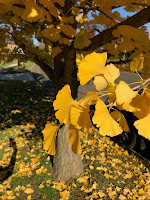 |
| Ginkgo Tree Leaves in Autumn |
A fascinating fact we found about the ginkgo tree is that it is a living fossil. The earliest leaf fossils are dated from 270 million years ago. It was rediscovered in 1691 in China and then brought over to our country in the late 1700s. The seeds and leaves are still used in medicine throughout the world. [Info from https://www.arborday.org/trees/treeguide/treedetail.cfm?itemID=1092]
I could go on and on, but I’ll finish with a few facts about maples and oaks. There are over 100 species of Maple trees. Maples have sweet sap and double-winged “helicopter” seeds or fruit. The leaves are varied in sizes, but maple leaves have 3 major pointed sections with tiny, stout lower sections by the stem of the leaf. Here are a few that we saw on our walk.
 |
| Silver Maple Leaves |
 |
| Sugar Maple Leaves |
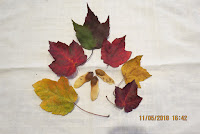 |
| Small Maple Leaves called Swamp Maple |
As for the Oak trees, there are approximately 600 existing species of oaks. But for my children’s purposes, we researched the two main groups:
The pointy-tipped Pin Oak are the red oak leaf trees. The red oak trees have the points on their leaves. I told my children to remember r-e-d, 3 letters for pointy p-i-n, 3 letters oak leaves.
 |
| Pointy leaf Red Pin Oak Tree |
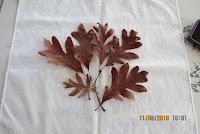 |
| Rounded finger White Oak Tree leaves |
The rounded finger oak leaves are the white oak trees. Again, I told my children to remember w-h-i-t-e, 5 letters for the r-o-u-n-d, 5 letters finger oak leaves.
But red oak or white, all oak leaves have the same amount of lobes or teeth, about eight. And all oak trees bear the acorn as fruit.
The leaves from the Red Oak Group have pointed lobes:
Black oak
Pin oak
Red oak
Sawtooth oak
Scarlet oak
Shingle oak
Shumard oak
Leaves from the White Oak Group have the rounded lobes:
Bur oak
Chestnut oak
Chinquapin oak
English oak
Swamp White oak
White oak
I hope you’ve learned something new by reading this post. Please feel free to share any knowledge you may have about nature or trees here at Camping with Five Kids. It would truly be appreciated. Enjoy your Holiday!




Very interesting. I didn't know that the ginkgo tree is a living fossil. That is pretty cool. Great post as always!
Thank you so much, Michelle for your kind words. They are appreciated more than you know. Yes, we found the ginkgo tree fossil thing quite fascinating.
It's always a pleasure seeing you here at Camping with Five Kids. Merry Christmas, my dear!
When I went to school we had 'Nature Studies', which involved identifying different trees, plants, animals, insects etc. None of that is taught anymore certainly not in the UK.
In this country an alarming number of children have misconceptions regarding the source of foods. Some think cheese comes from plants, bread and pasta from animals, chickens are fish and live in water and fish fingers come from chickens. Unbelievable.
This is a scary thing for sure, Bill. I feel the natural world and geography are very important for people to learn and understand–especially the young. For they will be in charge of this world after we are gone.
Thank you so much for sharing this with the readers at Camping with Five Kids, Bill. I truly appreciate it. All best to you, and enjoy your holiday!
Valuable information in your blog and I really appreciate your work and keep it up dude I really very informative blog about the Baby and baby care it's a nice work.
Baby
Nice post. it is very interesting and informative. Thank you for the sharing.
wood tools
"It's a rather interesting topic. We can pick up some life experience from here. It's a common knowledge that it's hard to bring up your kids. Moreover, if you combine your social life with studying, it's super hard. If you are looking where to buy a term paper online this site will meet all your requirements.my adventure tips
"